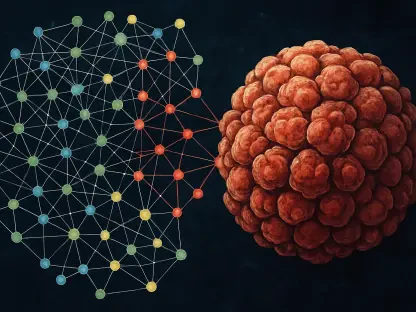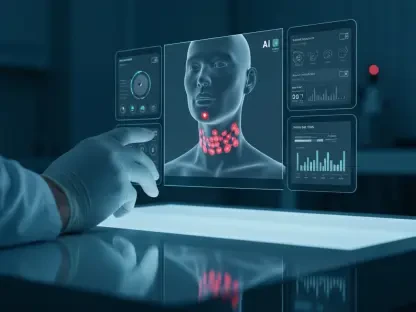Prostate cancer (PCa) remains a formidable challenge in the field of medical diagnostics, often leading to high mortality rates worldwide. Its detection primarily relies on MRI exams, which, despite being highly instrumental, present significant variability in interpretation among radiologists. This variability jeopardizes consistent and accurate diagnosis, subsequently impacting treatment plans and patient outcomes. Recent advancements highlight the promising role of artificial intelligence (AI) in enhancing the precision and consistency of interpreting biparametric MRI (bpMRI) scans. The aim is to improve the reliability of prostate cancer diagnoses, addressing both the current challenges and future opportunities in clinical imaging and patient care.
Exploring the AI Impact on MRI Interpretation
Insights from Recent Research
A pivotal study led by Dr. David Gelikman, published in the American Journal of Roentgenology, delves into AI’s prowess in transforming MRI interpretation for prostate cancer. This study intricately assessed how AI assistance influences radiologists’ accuracy when interpreting bpMRI scans. The participants, comprising six seasoned radiologists, analyzed scans from 180 patients, which included individuals who had undergone radical prostatectomy and others with negative biopsy results. The study meticulously evaluated AI in terms of lesion-level sensitivity, positive predictive value (PPV), and interreader agreement, alongside the area under the receiver operating curve (AUC) for the detection of clinically significant PCa. The introduction of AI yielded a notable improvement in lesion-level PPV and interreader agreement, indicating that AI could significantly reduce the variability inherent in individual interpretations and foster more reliable diagnostic outcomes.
Quantifying Accuracy Enhancements
The findings of Gelikman’s research are crucial, demonstrating that AI augmentation improved lesion-level PPV from 67.2% to 77.2% for identifying clinically significant prostate cancers. Alongside this, there was a substantial increase in interreader agreement for lesion-level PI-RADS scores, from κ = 0.336 to κ = 0.748. This suggests that AI can play a vital role in harmonizing interpretation standards among different radiologists, thereby increasing diagnostic fidelity. Although there was a slight decrease in lesion-level sensitivity, the overall patient-level AUC values remained consistently high with AI use, illustrating that AI-enhanced interpretations maintain diagnostic integrity even with these sensitivity changes. Such results underline the potential for AI not just to complement but to augment human expertise in diagnostic radiology, promoting standardized analytical approaches where currently none exist.
Future Implications and Research Directions
Integrating AI into Clinical Workflows
As AI technology continues to evolve, its integration into clinical workflows becomes increasingly viable and necessary. AI tools are poised to address the pressing challenges faced by radiologists, such as the labor-intensive and skill-sensitive nature of MRI interpretations. This integration could facilitate a seamless transition toward consistent, accurate, and swift diagnostic processes. However, for AI to be truly transformative, it must be implemented thoughtfully into established clinical workflows, ensuring that it complements rather than disrupts physician practices. The emphasis on more accurate and standardized results will empower healthcare providers and enhance patient outcomes, fostering a healthcare ecosystem that embraces technology-driven solutions efficiently and ethically.
The Call for Continued Research
Despite the promising outcomes, Gelikman’s study underlines the need for further research to refine AI algorithms, particularly in enhancing sensitivity without compromising specificity. Addressing these challenges requires a collaborative approach that leverages multidisciplinary expertise across technology, medical practice, and patient advocacy. Future studies should aim to explore diverse clinical scenarios, wider patient demographics, and varying stages of prostate cancer to capture more comprehensive data. By expanding the scope of research, stakeholders can help tailor AI solutions that address specific clinical needs, thus ensuring that AI integration actively contributes to evolving diagnostic standards while maintaining patient-centered care priorities. Such progression will undoubtedly pave the way for advances in artificial intelligence, unlocking new possibilities in healthcare diagnostics.
Rethinking Diagnostics with AI Innovations
Prostate cancer (PCa) remains a serious challenge in the realm of medical diagnostics, resulting in high mortality rates globally. Detecting PCa primarily depends on MRI exams. Although these exams are crucial tools, they often exhibit a considerable range of interpretation among radiologists, impacting the reliability of diagnoses. This variability has significant consequences on treatment strategies and patient outcomes, making accurate diagnosis essential. In recent years, there’s been notable progress in using artificial intelligence (AI) to mitigate these challenges. AI has shown great promise in improving the precision and consistency of interpreting biparametric MRI (bpMRI) scans, leading to more dependable prostate cancer diagnoses. The application of AI not only addresses current obstacles in the interpretation of imaging but also lays a foundation for future advancements in clinical imaging and patient care. By enhancing diagnostic accuracy, AI holds the potential to revolutionize treatment pathways, ultimately improving patient care and outcomes.









